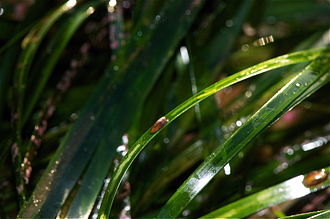Seagrass






Seagrass refers to a group of flowering plants that grow in marine environments. Unlike terrestrial grasses, seagrasses are adapted to live fully submerged in salty or brackish waters. They are key components of coastal ecosystems, providing habitat, food, and nursery areas for a wide variety of marine life. Seagrasses are not a taxonomic group but are classified in four families within the order Alismatales: Zosteraceae, Posidoniaceae, Cymodoceaceae, and Hydrocharitaceae.
Characteristics[edit]
Seagrasses share several adaptations that allow them to thrive in underwater environments. These include a rhizome system for anchorage and nutrient storage, long and narrow leaves to reduce resistance to water flow, and a unique pollination mechanism that does not rely on air transport. Seagrasses can reproduce both sexually, through flowers and seeds, and asexually, by rhizome extension.
Ecological Importance[edit]
Seagrasses play a crucial role in coastal ecosystems. They stabilize sediment, reducing erosion and improving water clarity. Seagrasses are also significant carbon sinks, absorbing carbon dioxide from the atmosphere at a rate higher than tropical forests. This makes them important players in the fight against climate change.
The dense beds of seagrasses provide shelter and food for a diverse array of marine organisms, including fish, crustaceans, and mollusks. Many commercially important fish species spend part of their life cycle in seagrass meadows, making these habitats critical to the fishing industry.
Threats[edit]
Seagrass meadows are among the most threatened ecosystems on the planet. They face numerous threats, including pollution, coastal development, dredging, climate change, and the introduction of invasive species. Nutrient runoff from agriculture and sewage can lead to eutrophication, causing harmful algal blooms that block sunlight necessary for seagrass survival. Rising sea temperatures and ocean acidification also pose significant threats to seagrass health.
Conservation[edit]
Efforts to conserve seagrass meadows include the establishment of marine protected areas, restrictions on coastal development and dredging activities, and initiatives to reduce water pollution. Restoration projects, which involve the replanting of seagrass shoots in degraded areas, have been undertaken in various parts of the world to help recover these vital ecosystems.

This article is a environment-related stub. You can help WikiMD by expanding it!
Ad. Transform your life with W8MD's Budget GLP-1 injections from $75


W8MD offers a medical weight loss program to lose weight in Philadelphia. Our physician-supervised medical weight loss provides:
- Weight loss injections in NYC (generic and brand names):
- Zepbound / Mounjaro, Wegovy / Ozempic, Saxenda
- Most insurances accepted or discounted self-pay rates. We will obtain insurance prior authorizations if needed.
- Generic GLP1 weight loss injections from $75 for the starting dose.
- Also offer prescription weight loss medications including Phentermine, Qsymia, Diethylpropion, Contrave etc.
NYC weight loss doctor appointmentsNYC weight loss doctor appointments
Start your NYC weight loss journey today at our NYC medical weight loss and Philadelphia medical weight loss clinics.
- Call 718-946-5500 to lose weight in NYC or for medical weight loss in Philadelphia 215-676-2334.
- Tags:NYC medical weight loss, Philadelphia lose weight Zepbound NYC, Budget GLP1 weight loss injections, Wegovy Philadelphia, Wegovy NYC, Philadelphia medical weight loss, Brookly weight loss and Wegovy NYC
|
WikiMD's Wellness Encyclopedia |
| Let Food Be Thy Medicine Medicine Thy Food - Hippocrates |
Medical Disclaimer: WikiMD is not a substitute for professional medical advice. The information on WikiMD is provided as an information resource only, may be incorrect, outdated or misleading, and is not to be used or relied on for any diagnostic or treatment purposes. Please consult your health care provider before making any healthcare decisions or for guidance about a specific medical condition. WikiMD expressly disclaims responsibility, and shall have no liability, for any damages, loss, injury, or liability whatsoever suffered as a result of your reliance on the information contained in this site. By visiting this site you agree to the foregoing terms and conditions, which may from time to time be changed or supplemented by WikiMD. If you do not agree to the foregoing terms and conditions, you should not enter or use this site. See full disclaimer.
Credits:Most images are courtesy of Wikimedia commons, and templates, categories Wikipedia, licensed under CC BY SA or similar.
Translate this page: - East Asian
中文,
日本,
한국어,
South Asian
हिन्दी,
தமிழ்,
తెలుగు,
Urdu,
ಕನ್ನಡ,
Southeast Asian
Indonesian,
Vietnamese,
Thai,
မြန်မာဘာသာ,
বাংলা
European
español,
Deutsch,
français,
Greek,
português do Brasil,
polski,
română,
русский,
Nederlands,
norsk,
svenska,
suomi,
Italian
Middle Eastern & African
عربى,
Turkish,
Persian,
Hebrew,
Afrikaans,
isiZulu,
Kiswahili,
Other
Bulgarian,
Hungarian,
Czech,
Swedish,
മലയാളം,
मराठी,
ਪੰਜਾਬੀ,
ગુજરાતી,
Portuguese,
Ukrainian